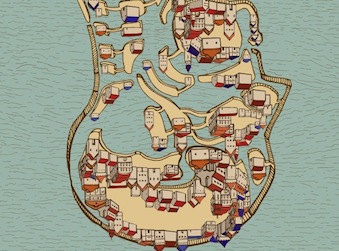The map of human behaviour is upside down
Share

I was fortunate enough to last night attend the Account Planning Group’s event with Mark Earls in Melbourne, where the ‘recovering account planner’, speaker and author (HERD, I’ll Have What She’s Having) spoke on his contrarian approach to behaviour change.
The general theme of Earls’ work is that behavioural economists, neuropsychologists and evolutionary psychologists are looking in the wrong place to find the key to understanding human behaviour and how to change it. (His analogy for this is cartography – we’ve in the past relied on incorrect maps without knowing it, only to find out much later they were put together less than accurately, whether through laziness, relying on hearsay, or whatever).
In marketing, advertising or any other situation in which we need to understand or seek to influence human behaviour, Earls suggests we ask ourselves this: “is the behaviour shaped by what goes on between the ears, or is it shaped by what goes on between people?” That is, does the behaviour (which could be a decision to purchase a particular product, to give to a particular charity, or to participate in a riot) come from the individual independently or through social cues? Earls maintains that much more behaviour is socially driven than we think.
Last night he presented four points – myths about human behaviour that need busting:
1. Post-rationalisation
People do things first and make sense of it later. For the most part, attitudes change because of behaviour, not the other way around.
2. Spock < Kirk
We’re not like Spock. We’re impulsive, intuitive, emotional, and irrational, like Kirk. Logic is the slow system, while impulse is thousands of times faster. Earls suggests most marketing that spruiks rational product benefits and encourages the viewer to think is working against itself – if you want people to do something, don’t make them think about it. To paraphrase American psychologist and Nobel laureate Daniel Kahneman: “Human beings are to thinking as cats are to swimming.” We can think if we have to, but we’d really rather avoid it as much as possible.
3. Maximiser or satisficer?
We’re not maximisers. That is, we’re not looking for the best for ourselves. Whatever people tell you, they’re actually just looking for what’s good enough.
4. All together
When we’re faced with challenges or uncertainty, we mostly do what others are doing. Social is the number one learning style, because taking cues from others is a shortcut to avoid the slow route of thinking to determine a solution. In fact, in most situations, out of all possible decision choices there may be many that are objectively pretty good, so choosing rationally can be almost impossible. You can prove this point by asking a room of people to find a partner, face each other, hold each other’s wrists and see for how long they can hold the other off the ground in a 20-second period. The reaction across the board begins with ‘WTF does that mean?’ followed by glances around the room to see what everyone else is doing, which leads to the entire room jumping on the spot. (Was a lovely way to meet you, Gideon).
The first step to being able to influence behaviour is to understand what kind of behaviour it is: social or independent. Examples of socially-driven behaviours are the music we listen to, the charities we give to, what drink we order and who we vote for. Independent choices are things like the deodorant and car insurance brands we purchase.
To show that much more behaviour is socially driven than we think, and as an example of the problems caused by misunderstanding the real reasons behind human behaviour, Earls points to the London riots of August 2011. The response from authorities was to punish and/or understand each individual involved. Turning that on its head is the hypothesis that the decision to take part in the riots was a social one, not one arrived at independently by each individual involved. While those involved may never say ‘the big boys made me do it,’ social pressures are by and large the dominant driver.
As a parting piece of advice for the room full of planners, but which can just as easily apply to all involved in the wider marketing and communications professions, Earls implores us to focus on the connections and the space in between people, rather than the people themselves.















